Key Insights
- The Worldwide Asset eXchange (WAX) is a Layer-1 (L1) blockchain built using the open-source Antelope framework (formerly called EOSIO) with additional built-in services providing a more familiar Web2 experience.
- WAX is geared toward blockchain gaming and NFT use cases.
- WAX is among the leaders of L1s in network activity with over 20 million daily transactions and around 350,000 daily active addresses.
- After introducing an account creation fee in Q1’22 partially to deter bots, account growth decreased 85% month-over-month and has not rebounded.
- Roadmap items include horizontally scaling the blockchain, furthering UX improvements, and continuing to attract Web2-caliber gaming projects.
Blockchain gaming is a popular answer to the question of what will be the catalyst for the next bull cycle. Video gaming and eSports are growing industries and many believe that blockchain technology and its ethos, namely full-ownership of in-game assets, can revolutionize the gaming experience.
WAX is an L1 that was one of the first blockchains to launch with the dedicated purpose of hosting gaming and NFT use cases. WAX’s founders began building it while running a popular centralized marketplace for in-game CS:GO assets and witnessing the downsides of the traditional gaming model where users don’t truly own their assets. Since its launch, WAX has been one of the most popular L1s among gaming and NFT users; however, their early lead with respect to total NFT sales volume has waned as incumbents have arrived. Nevertheless, if the team successfully implements technical improvements to horizontally scale the chain and attracts high-caliber gaming projects, WAX will be positioned to lead the growing blockchain gaming sector.
Background
WAX sprouted out of OPSkins, a digital marketplace for video game skins founded in 2015. OPSkins became one of the top third-party marketplaces to trade in-game assets of Counter-Strike: Global Offensive (CS:GO). While competing with centralized entities and hosting in-game assets from centralized games, the OPSkins team recognized the need to create a decentralized marketplace and encourage a more decentralized gaming ecosystem.
In 2017, WAX was founded by OPSkins co-founders and executives William Quigley (WAX CEO), Jonathan Yantis (WAX COO), and John Brechisci (WAX Lead Designer). At first, WAX was an ERC-20 token while the team worked on building the decentralized marketplace. WAX held a public initial coin offering (ICO) on Ethereum at the end of 2017, raising around $60 million. The token was used on OPSkins as payment for buying and selling video game items.
After over a year in beta, the WAX blockchain officially launched in June 2019. WAX ERC-20 token holders could exchange them for native WAX Protocol (WAXP) tokens. With the WAX blockchain and marketplace live, OPSkins eventually closed down in 2020. In June 2022, WAX raised another $10 million in funding from OKX.
Technology
WAX is built using the open-source Antelope blockchain protocol, which powers other public blockchains including EOS and Telos. On top of the base-layer protocol, WAX has built other services core to its technological stack, including a cloud-based wallet, an NFT creator and marketplace, an on-chain random number generator, and a block explorer. Many aspects of WAX are designed with the goal of providing a more familiar Web2 experience.
Consensus
Mechanism
WAX is a Byzantine Fault Tolerance (BFT) based blockchain that uses the popular Proof-of-Stake (PoS) variant Delegated PoS (DPoS). In this system, WAXP token holders can delegate their tokens to validators (“WAX Guilds”), who produce and validate blocks.
The top 21 guilds based on delegated voting stake participate in consensus each round (“participating guilds”). Participating guilds produce blocks at the same share, irrespective of their delegated voting power. The order in which guilds participate in consensus is pre-determined based on geographical proximity. By minimizing the geographic distance between each guild from one block to the next, latency can be reduced.
The next 24 highest guilds after the top 21 are known as standby guilds. If a participating guild becomes unavailable in any way, whether it unregisters, has downtime, or otherwise, standby guilds can fill in. Standby guilds are chosen to fill in based on which has the highest amount of votes.
Rewards and Penalties
Guilds earn 40% of the network’s 5% annual inflation in the form of block rewards. Of this 40%, 60% is allocated equally to participating guilds with the other 40% allocated equally to standby guilds.
Delegators also earn 40% of the network’s 5% annual inflation, proportional to their stake weight and voting activity. Delegator’s rewards do not depend on which validator one delegates to. Delegators are incentivized to vote weekly (i.e., stake their tokens to guilds), the exact mechanics of which will be discussed more in the tokenomics section.
There are no protocol-level penalties for guilds misbehaving or being inactive. However, a third-party Office of Inspector General body (OIG) publishes monthly guild evaluations. These evaluations can help persuade users to remove delegation from a misbehaving or inactive guild.
Computation
Smart Contract Programming Language
Smart contracts are written in C++, which is one of the most popular languages for Web2 developers.
Resource Model
Many blockchains have a gas-based resource model where a user spends a gas token to cover the various costs of a transaction, including processing the transaction and storing the data. On WAX, the resources typically combined into one gas fee are separated into their own components. Furthermore, in most cases, WAXP tokens allocated for WAX resources are not permanently spent but can be recouped by the user if they no longer need that resource.
The three resource components on WAX are:
- NET is a space-denominated resource that measures WAX’s throughput capacity in bytes.
- CPU is a time-denominated resource that measures the processing time of a transaction in microseconds.
- RAM measures the data storage capabilities of WAX in kilobytes.
Bandwidth: Together, NET and CPU cover the bandwidth costs of the network. They are both regenerable resources that are acquired by staking WAXP. The staking is done through the same smart contract as staking for consensus, allowing users to allocate the same WAXP toward both. NET and CPU are available to users proportional to their share in each of the resource’s staking contracts and depending on network activity. When the chain is busier, the same proportional stake would give fewer bandwidth resources, and vice versa. Each block has a global limit of 0.20 seconds of CPU and 1,024 KB of NET. When a user has a transaction that requires NET or CPU, the resource is temporarily consumed, regenerating back to the user after 24 hours. Users can unstake their WAXP and receive the tokens after a 72-hour period.
State Storage: Through RAM, users pay directly for the costs associated with storing the data in their account, including any fungible tokens, NFTs, NFT listings, and more. RAM is a finite resource that can be bought and sold against WAXP. The RAM/WAXP market is priced using the Bancor liquidity algorithm. The market has a 0.5% fee which is collected and burned. New accounts cost 1611 bytes of RAM to create, which at the current price of 0.5 WAXP per KB of RAM costs around $0.05. Unlike typical gas tokens, RAM is not always permanently spent. For example, if a user allocates RAM to an NFT they hold, that RAM is returned to them if they burn the NFT (selling or transferring the NFT to another account will not release back RAM).
To ease the onboarding experience, wallet providers can charge an account creation fee which is used to fund the initial RAM and stake some WAXP toward CPU and NET on behalf of users.
Application developers are also able to subsidize RAM or stake WAXP for their users. In the case of staking WAXP for bandwidth, the wallet provider or developer retains ownership of the WAXP staked, while the CPU and NET earned can be allocated to beneficiaries.
Accounts
Architecture
WAX accounts have two key roles: an admin key and an active key. The two roles have the same default permissions, except an active key cannot add or remove other active keys. Furthermore, admin keys can set up active keys with custom permissions. For example, there could be an active key that is only able to do one specific action, such as mint NFTs. A user could also create several keys and require multiple signatures to execute transactions.
This system has similar effects to account abstraction and is a significant improvement in UX and security compared to traditional accounts that are not smart contracts. Account abstraction has notably been on Ethereum’s roadmap for many years.
WAX Cloud Wallet
The WAX team built the WAX Cloud Wallet, which provides an easier onboarding experience for Web2 users. The wallet allows users to create an account with 2FA and Web2 credentials, such as an email and password, or with Facebook, Google, WeChat, Steam, and other services. Since the beginning of 2021, over 91% of new WAX accounts joined through WAX Cloud Wallet.
Beyond abstracting away seed phrases, the WAX Cloud Wallet has other UX advantages including allowing users to execute transactions without having to click to sign each one once they’ve logged on and begun a session. However, the UX benefits are a tradeoff with trustlessness, as each user’s Cloud Wallet admin key is a two-of-four multi-sig consisting of WAX’s President, COO, CTO, and Blockchain Lead. The team is planning an update to transfer admin key ownership to the user, more details of which can be found in the roadmap section.
Beginning in 2022, new Cloud Wallet users are required to pay an account creation fee of 5 WAXP, which can be sent either in WAXP from centralized exchanges or with a credit card via MoonPay. The change was done to prevent bots and spam account creation. Upon creating a Cloud Wallet account, users are provided with the initial 1611 RAM and have enough WAXP staked toward bandwidth resources to transact on average 12 times a day.
Tokenomics
Overview
WAX’s native token WAXP is used for network security (validator and delegator staking) and resource allocation (CPU and NET staking, RAM buying and selling). At launch, 1.8 billion WAXP tokens were minted. WAXP has a 5% annual inflation rate and 0.4% of all NFT secondary sales are collected in WAXP and burned.
Initial Distribution

Ecosystem Fund (30%): This pool of funds is used along with 30% of the ICO proceeds (see below) to further the WAX ecosystem. This has included building and operating tools such as the Cloud Wallet, recruiting and partnering with brands to build on WAX, marketing costs, and other development costs. These tokens were liquid upon launch.
Team and Founders (25%): A quarter of the initial token supply was distributed to the WAX team and founders. These tokens were liquid upon launch.
Public Token Sale (18.3%): 347.5 million tokens were sold in two public token sale tranches on Ethereum at the end of 2017. 210 million tokens were sold at a price of 3,000 WAXP per ETH (around $0.10 per WAXP at the time). The remaining 137.5 million tokens were sold at an average price of 2,250 WAXP per ETH (around $0.14 per WAXP at the time). Together, the public token sale raised around $40 million at the time of the sale. These tokens were liquid upon launch.
Private Token Sale (16.7%): At the same time as the first public token sale tranche, 300 million tokens were sold to private investors at an average price of 4290 WAXP per ETH (around $0.07 per WAXP at the time). The private token sale raised around $21 million at the time of the sale. These tokens were liquid upon launch.
ICO (both public and private) proceeds went to: 35% operational overhead, 35% software development, and 30% ecosystem fund.
Contributors and Advisors (10%): Tokens were allocated to early contributors and advisors. These tokens were liquid upon launch.
All 1.8 billion tokens allocated at launch were automatically staked. Holders could earn up to double their original allocation if they kept their tokens staked for three years. For every 1 genesis token, a user kept staked, they earned 1/1096 additional tokens per day. Once a user unstaked, they could no longer re-stake to earn these genesis rewards. WAXP’s current supply is 2.35 billion, indicating that many users preferred instant liquidity instead of these additional rewards.
Inflation and Burning Mechanism
Since its launch, there has also been a 5% total annual inflation on top of the genesis token reward program. The 5% is distributed to:
- Staking rewards (40%): Users can stake their tokens and vote for delegators. A user’s rewards are multiplied by their vote strength. Anytime a user votes, their vote strength goes to 1. Thus if a user votes weekly, they will always earn their full rewards. If not, their vote strength slowly decays until it reaches 0. If they vote again, it’ll return straight to 1. User staking rewards do not depend on which guild one delegates to, or whether it’s a participating or standby guild. Instead of having to manage weekly voting oneself, a user can also delegate to a proxy, who votes for validators on behalf of users. Proxy voters do not receive any cut of the rewards.
- Block producers (40%): Of the 40%, 60% of block producer rewards go to participating guilds and 40% go to standby guilds.
- Worker proposal system (20%): The worker proposal system (WPS) gives out grants and other incentives to developers and community members to build on WAX. The fund is managed by WAX Labs, which is made up of the WAX team and OIG. The WPS is generally split into five categories: oversight, infrastructure, community, development, and miscellaneous. The WPS migrated to a new system in late 2021. Since then, $230,000 and 2 million WAX ($135,000 as of January 31, 2023) has been distributed to 27 completed projects.
The WAX network takes a 2% fee any time WAX NFTs are bought or sold on secondary marketplaces. This is not enforced at any protocol level, but there is a “gentleman’s agreement” with NFT marketplaces to participate. Of the 2%, 20% of the fees collected are burned. Thus, WAXP is burned at a rate of 0.4% of all NFT sales volume. The other 80% of the 2% network fee is used for liquidity mining rewards in WAX DeFi (see the Ecosystem DeFi section for more details).
Since the beginning of 2021, almost 8.2 million WAXP have been burned. At an annualized rate and based on current circulating supply figures, this amounts to a yearly burn rate of around 0.17%. Thus, the burn rate has only slightly reduced inflation in the past two years (from 5% to ~4.83%). Furthermore, the burn rate is highly dependent on network activity and prices. In the past 12 months, only 2.5 million tokens have been burned, a roughly 0.1% annual burn rate.
Network Activity and Ecosystem
Network Activity
Users and Developers

In Q2’21 WAX experienced a dramatic rise in network activity that continued throughout the previous bull market. Even after the bull market ended, activity has largely remained steady. Currently, WAX averages over 20 million daily transactions and around 350,000 daily active addresses. These figures place WAX among the leaders in both metrics among all blockchains.
However, these metrics are likely inflated by bot activity, as is expected for a network driven by gaming activity. As detailed below, many of the initially popular games on WAX were ones incentivizing users to repeatedly click buttons, which are prime for bot usage. For example, the once-popular high-click game Farmers World still sees 60,000 daily active addresses, despite the team ceasing development and leaving with the initial funding. This effectively makes the project dead. Nevertheless, bot activity occurs on many popular games and is not exclusive to WAX.
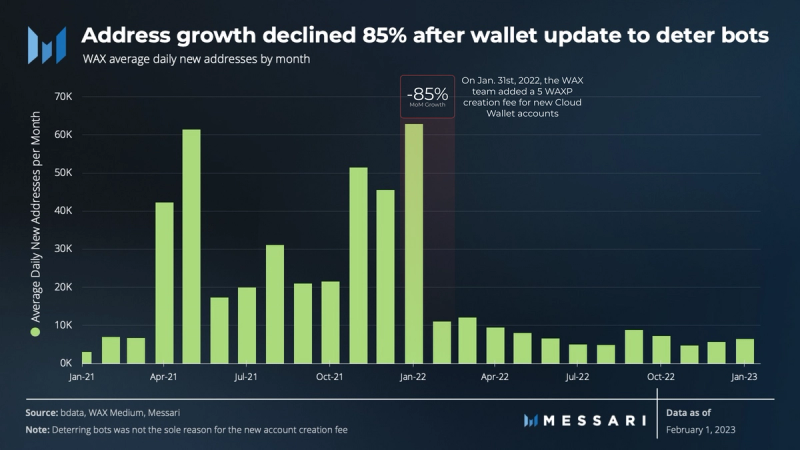
Although daily active addresses have remained constant over the past year and a half, account growth has slowed. So far in 2023, WAX has averaged just over 4,000 new accounts per day, a significant decrease from 2022 (almost 10,000 new addresses per day on average) and 2021 (over 31,000 new addresses per day on average).
Address growth sharply declined from the end of January 2022 to the beginning of February 2022. The decline was likely due to the new account creation fee of 5 WAXP for WAX Cloud Wallets implemented on January 31, which was done partially to deter the creation of bots and spam accounts.
Since the beginning of April 2021, WAX’s market cap rank has followed the trend in account growth more closely than daily transactions or active addresses, falling from 147th to 163rd.
Validators and Delegators
There are currently 65 validators with WAX voting power. Together, they stake over 1.6 billion WAXP, around 70% of the circulating supply. Voting power is very well distributed among the top 21 validators, with each participating validator having between 4.26-4.58% of the voting power. With 21 validators that produce blocks at an equal rate, irrespective of delegated voting stake, the network will always have a Nakaomoto coefficient of 8, slightly above the median of chains compiled on nakaflow.io.
Around two-thirds of the staked WAXP is delegated through proxies. Almost all WAXP delegated through proxies use the OIG as their proxy.
Ecosystem

NFTs and Gaming
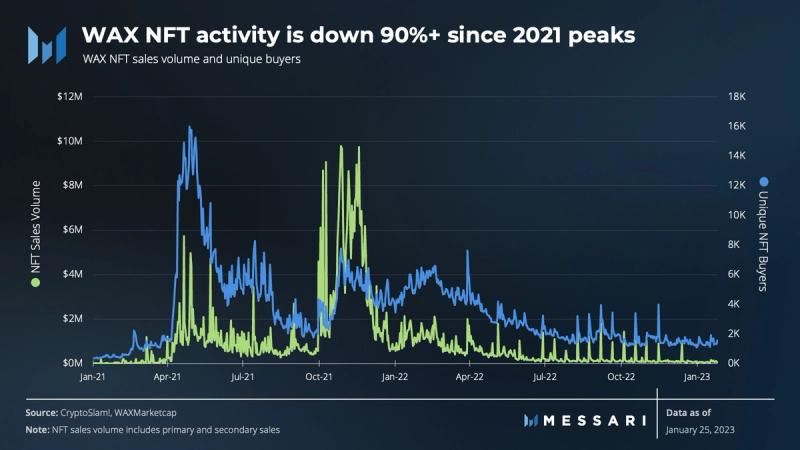
Daily unique NFT buyers on WAX peaked in Q2’21 at almost 16,000. However, it wasn’t until the second wave of the previous bull market in Q4’21 that daily NFT sales volume peaked at almost $10 million. Both figures are down over 90% since their peaks and continued to fall throughout 2022. In the past month, there has been an average of 1,400 unique buyers and $75,000 in total daily sales.
Popular NFT marketplaces include AtomicMarket and NeftyBlocks. AtomicMarket has averaged almost 15,000 daily unique addresses since 2021 and facilitates most secondary sales volume. NeftyBlocks has averaged 2,700 daily unique addresses since 2021 and facilitates most primary sales volume.
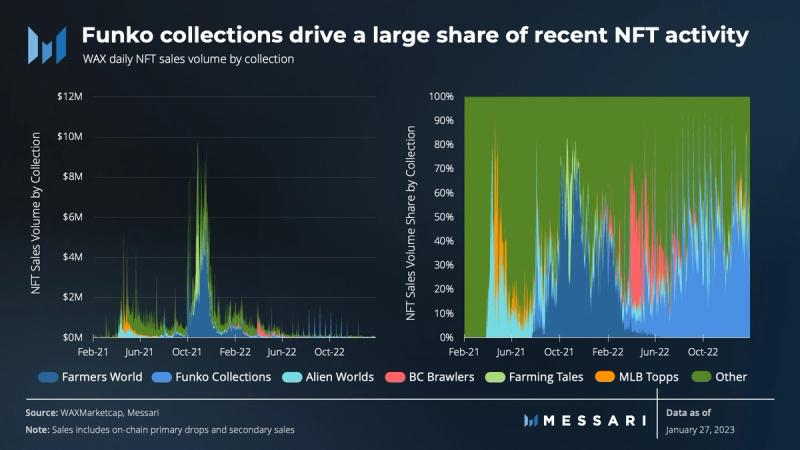
Farmers World is WAX’s all-time leading NFT collection with over $205 million in sales volume. Farmers World is a high-click farm mining game. In late 2021, however, the team sold the entire treasury (worth around $50 million at the time) and halted all development and communication. Despite this, Farmers World has averaged almost 90,000 daily unique addresses since 2022 and continues to see some sales volume.
Other popular games and collections of all-time include:
- Alien Worlds: a high-click outer space mining game, which recently also launched a PVP battle mode. It has over $40 million in NFT sales since its launch in early 2021. Since 2021, Alien Worlds leads WAX dapps in daily unique addresses with an average of over 200,000.
- Farming Tales: a high-click farm-building game. It has almost $38 million in NFT sales since its launch in mid-2021.
- MLB Topps: licensed MLB trading cards by leading manufacturer Topps. It has over $21 million in sales since its launch in mid-2021.
- Blockchain Brawlers: a PVP card game developed by the WAX team where players battle their digital wrestlers. It has almost $15 million in NFT sales since its launch at the end of 2021. BC Brawlers has averaged 1,500 daily unique addresses since launch. However, since mid-Q3’22, this figure is down to double digits.
These collections are WAX’s all-time leaders in sales volume as they were all popular during the previous bull market. Since then, not only have each collection’s absolute sales volumes decreased, as is expected in a bear market, but it has also lost most of its respective market share compared to its peak.
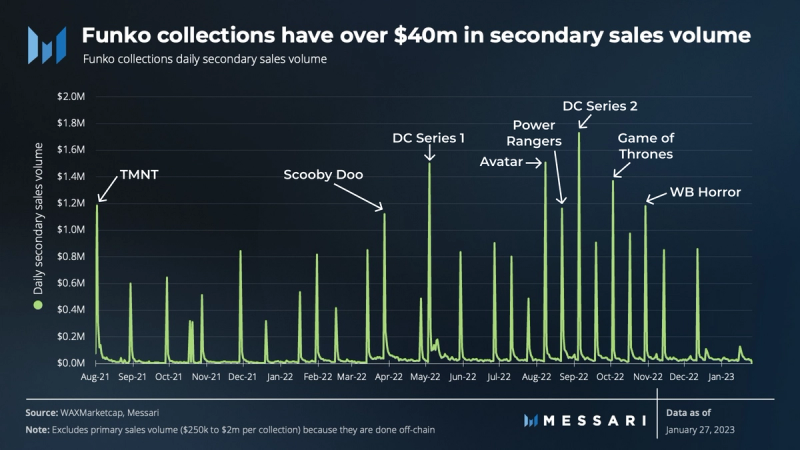
Since early 2022, Funko collections have emerged as WAX’s leading NFT collection by sales volume, with over $40 million since launch. Funko is a toy company that sells licensed pop culture collectibles. In 2021, it partnered with WAX to launch digital collectibles, some of which are redeemable for physical toys. So far, it has launched 30 collections featuring brands such as DC, TMNT, Scooby Doo, Nickelodeon Cartoons, and more. The drops feature packs of digital trading cards that users can purchase using credit cards, Apple Pay, and Google Pay. Each drop has sold out, bringing in $250,000 to $2 million per drop depending on collection sizes. However, these sales amounts are not included in the above data since the purchases occurred off-chain.
Whereas many of the older games on WAX are simpler high-click games, many new and upcoming games feature more advanced gameplay and graphics, including:
- Forge Arena: a tactical shooter game created by OPSkins founders that will be launching on the Epic Games Store soon.
- Avalon: an open-world fantasy MMORPG on WAX, Ethereum, Polygon, and BNB Chain.
- Immersys: a multiverse MMORPG.
DeFi
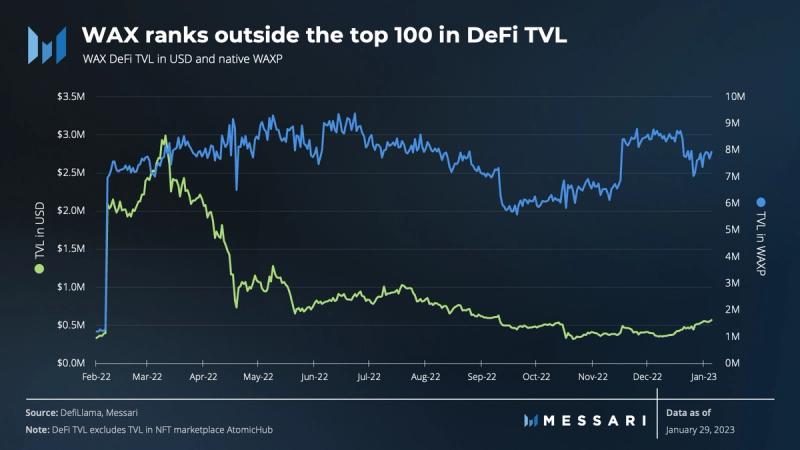
On WAX: With a focus on gaming and NFTs, WAX’s DeFi ecosystem is underdeveloped compared to other blockchains. With a TVL of $570,000, WAX ranks 125th among all ecosystems. The main DeFi protocol on WAX is Alcor Exchange, a decentralized exchange with automated market-making and order book features. Alcor Exchange has facilitated around $170,000 in volume in the past week. Since 2021, Alcor has had an average of 2,500 daily unique addresses.
Another indication of WAX’s sparse DeFi ecosystem is the absence of any natively minted stablecoins. The WAX team has brought over several Ethereum native stablecoins via a two-of-four multi-sig bridge (with the same signers as the Cloud Wallet), namely USDC, USDT, and DAI. However, their usage on WAX has been low, with only around 25,000 tokens circulating outside the bridge.
On Ethereum: In 2020, the WAX team announced a new DeFi system that would launch on Ethereum, eventually going live at the beginning of 2021. With WAX optimizing for gaming and NFTs, the WAX team acknowledged Ethereum as a superior environment for DeFi.
The team built a token bridge between Ethereum and WAX. The bridge uses a mint and burn mechanism with WAXP holders receiving WAXE tokens on Ethereum at a ratio of 1,000 WAXP to 1 WAXE. For security, the bridge relies on the two-of-four multi-sig used for the Cloud Wallet and stablecoin bridges. Bridges depending on multi-sigs for security have been the subject of several large hacks to date. To mitigate loss in a potential hack, the bridge limits the amount a user can transfer per hour and day as well as having a global daily transfer limit.
After bridging to Ethereum, WAXE holders can add liquidity to a WAXE-ETH pool and receive a WAXE-ETH liquidity token in return. Liquidity providers can stake their liquidity tokens in the Distribution Pool to earn WAXE rewards.
As mentioned above, 2% of the volume of NFT secondary sales is collected as a network fee. Of the 2%, 80% are bridged over to Ethereum and half goes to the Distribution Pool. Tokens are distributed every four weeks and a user must stake for the entire four-week period in order to receive rewards.
The WAX team also created a new WAX Governance token (WAXG). Distribution Pool stakers earn WAXG on top of their WAXE rewards, but only if the price of WAXE did not decrease during the four-week staking period. WAXG holders can burn their tokens to receive WAXE stored in the PiggyBank Pool. The other half of the 80% of the network fees collected are stored in the PiggyBank Pool. If a WAXG holder burns their tokens, they receive WAXE in the pool proportional to their share of WAXG relative to the circulating supply. 10 million WAXG tokens were initially minted. Half of them are allocated to Distribution Pool rewards with the other half reserved in a treasury for future use.
The WAXE-ETH Uniswap V2 pool currently has over $6 million in TVL. However, the team plans to migrate the system back to WAX around the end of 2023.
Roadmap
Technical Improvements
Antelope: In Q3’22, the teams of EOSIO-based networks including WAX, EOS, Telos, and UX Network collectively formed the Antelope Coalition. The Antelope Coalition will fund and accelerate the development of the Antelope protocol, a rebranding from EOSIO. Antelope released a blue paper detailing its plans to improve scalability across several areas including:
- State Storage: As more wallets are created on Antelope blockchains, block producers will require more expensive hardware to store the state. The blue paper proposes to reduce the amount of state RAM that block producers need to store physically.
- TPS and Finality: Currently, Antelope blockchains can process around 8,000 transactions per second (TPS) with three minutes for finality. The Antelope group is looking to improve these figures by implementing a near-immediate BFT deterministic finality mechanism based on the HotStuff mechanism and parallel transaction processing.
- IBC: Another method by which the group plans to horizontally scale Antelope blockchains is by implementing a light-client inter-blockchain communication (IBC) protocol similar to Cosmos’ IBC. Beyond enabling secure interoperability between Antelope chains, it will allow popular dapps to create their own Antelope sidechain that remains connected to the ecosystem.
The Antelope group also hopes to spur developer activity by creating better documentation and tooling.
WAX plans on upgrading to Antelope 3.1 in Q1’23. The Coalition will continue upgrading Antelope to implement the above items and more.
Tokenomics: The WAX team is planning an overhaul of WAXP tokenomics and staking mechanisms in Q1 or Q2 2023. The number of rewards to various network participants including block producers, delegators, WAX Labs, and others will remain roughly the same. However, more network fees will be taken from activity beyond NFT secondary sales and the RAM/WAXP market. If these fees cover the rewards, no additional WAXP will be minted (and any fees left over will be burned). However, if there’s not enough activity to cover the rewards, inflationary WAXP will be minted to cover the difference. In the proposed system, inflation will not exceed 4%.
WAX Cloud Wallet: The WAX team is planning a complete redesign of the Cloud Wallet in Q1’23. This includes a new onboarding system, allowing users to create a Cloud Wallet account without creating a WAX blockchain account until their first blockchain interaction. The team also plans to update the wallet’s permission system, as mentioned in the accounts section above. Users, instead of the WAX team’s multi-sig, will become the admin key of their account. The team’s multi-sig will by default remain as a signer on the account. A user can remove this key, reclaiming full ownership of their account. However, it comes with a tradeoff in UX as they will have to manually sign each transaction.
WAX’s full roadmap for 2023 can be found here.
Growth Strategy
Beyond technical improvements, the WAX team plans to grow the ecosystem by forming partnerships and giving out developer grants. Many well-known Web2 brands have built on WAX. Beyond the Funko collections, WAX has partnered with Spiderman, Hot Wheels, Street Fighter, Deadmau5, and others to launch NFT collections. The WAX team, together with the OIG, will continue to allot grants using funds from the WPS. The WPS currently has 245,000 WAX, and receives around 23 million WAXP ($1.5 million as of Jan. 31, 2023) per year based on current tokenomics.
Closing Summary
WAX was one of the early movers in the blockchain gaming and NFT space. The chain has hosted several popular play-to-earn games and many NFT collections from large Web2 brands. Since it peaked in 2021, NFT sales volume and unique buyers have fallen 90%. In that time, WAX has also fallen behind several incumbents with respect to those metrics. However, if the WAX team can successfully implement its technical roadmap and attract Web2-caliber games to build on WAX, the network could very well reclaim its spot as a leading gaming and NFT L1.



















